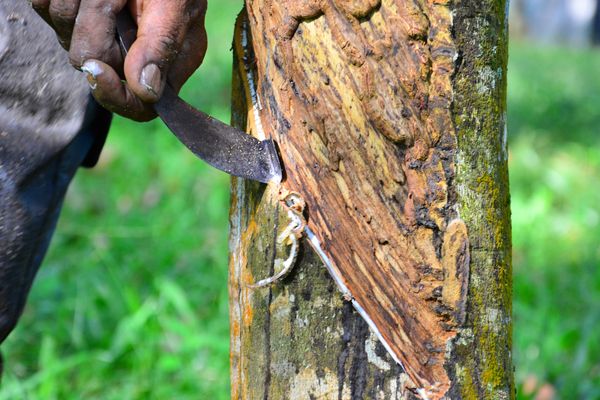3.4.10
Investigating Plant Transport
Investigating Mass Transport in Plants
Investigating Mass Transport in Plants
Mass transport can be investigated in two ways.


Ringing
Ringing
- Ringing can be used to investigate mass transport in the phloem.
- Phloem vessels are located outside the xylem vessels in the stem of a plant.
- If a ring is cut around the outside of a stem, this halts transport in the phloem but allows transport in the xylem to continue.
- Eventually, the tissue above the ring begins to swell and growth stops below the ring because sucrose cannot be transported.


Tracing
Tracing
- Sucrose produced during photosynthesis can be tracked by exposing the leaves of a plant to carbon dioxide containing radioactive carbon.
- The plant is frozen very quickly in liquid nitrogen and placed onto photographic film.
- The pathway travelled by the radioactive sucrose down the phloem can be traced.


Evidence for mass transport
Evidence for mass transport
- Tracing and ringing experiments provide evidence for the mass flow theory.
- Both types of investigation show a causal link between the phloem and sucrose transport.
Evidence Against Mass Flow
Evidence Against Mass Flow
Although ringing and tracing provide evidence for the mass flow hypothesis, there are some anomalies.


Direction of flow
Direction of flow
- Sap can move up or down the phloem vessels.
- The hydrostatic pressure gradient that is set up by water entering the source and leaving at the sink does not explain how sap can move in both directions.


Sieve plates
Sieve plates
- Sieve plates are the pores between sieve tube elements.
- Increased hydrostatic pressure is required for water to flow through the pores.
- This means that sieve plates should present a problem for the mass flow.


Living phloem cells
Living phloem cells
- Phloem cells are living and xylem cells are non-living.
- The purpose of phloem cells being living is unclear.
1Biological Molecules
1.1Monomers & Polymers
1.2Carbohydrates
1.3Lipids
1.4Proteins
1.4.1The Peptide Chain
1.4.2Investigating Proteins
1.4.3Primary & Secondary Protein Structure
1.4.4Tertiary & Quaternary Protein Structure
1.4.5Enzymes
1.4.6Factors Affecting Enzyme Activity
1.4.7Enzyme-Controlled Reactions
1.4.8End of Topic Test - Lipids & Proteins
1.4.9A-A* (AO3/4) - Enzymes
1.4.10A-A* (AO3/4) - Proteins
1.4.11Diagnostic Misconceptions - Enzyme Inhibitors
1.5Nucleic Acids
1.6ATP
1.7Water
1.8Inorganic Ions
2Cells
2.1Cell Structure
2.2Mitosis & Cancer
2.3Transport Across Cell Membrane
2.4Cell Recognition & the Immune System
2.4.1Immune System
2.4.2Phagocytosis
2.4.3T Lymphocytes
2.4.4B Lymphocytes
2.4.5Antibodies
2.4.6Primary & Secondary Response
2.4.7Vaccines
2.4.8HIV
2.4.9Ethical Issues
2.4.10End of Topic Test - Immune System
2.4.11Exam-Style Question - Immune System
2.4.12A-A* (AO3/4) - Immune System
2.4.13Diagnostic Misconceptions - Humoral vs Cellular
3Substance Exchange
3.1Surface Area to Volume Ratio
3.2Gas Exchange
3.3Digestion & Absorption
3.4Mass Transport
3.4.1Haemoglobin
3.4.2Oxygen Transport
3.4.3The Circulatory System
3.4.4The Heart
3.4.5Blood Vessels
3.4.6Cardiovascular Disease
3.4.7Heart Dissection
3.4.8Xylem
3.4.9Phloem
3.4.10Investigating Plant Transport
3.4.11End of Topic Test - Mass Transport
3.4.12A-A* (AO3/4) - Mass Transport
3.4.13Diagnostic Misconceptions - Concentration Gradient
3.4.14Diagnostic Misconceptions - Cardiac Cycle
3.4.15Diagnostic Misconceptions - Carrying Capacity
3.4.16Diagnostic Misconceptions - Translocation
4Genetic Information & Variation
4.1DNA, Genes & Chromosomes
4.2DNA & Protein Synthesis
4.3Mutations & Meiosis
4.4Genetic Diversity & Adaptation
4.5Species & Taxonomy
4.6Biodiversity Within a Community
4.7Investigating Diversity
5Energy Transfers (A2 only)
5.1Photosynthesis
5.1.1Overview of Photosynthesis
5.1.2Photoionisation of Chlorophyll
5.1.3Production of ATP & Reduced NADP
5.1.4Cyclic Photophosphorylation
5.1.5Light-Independent Reaction
5.1.6A-A* (AO3/4) - Photosynthesis Reactions
5.1.7Limiting Factors
5.1.8Photosynthesis Experiments
5.1.9End of Topic Test - Photosynthesis
5.1.10A-A* (AO3/4) - Photosynthesis
5.2Respiration
5.2.1Overview of Respiration
5.2.2Anaerobic Respiration
5.2.3A-A* (AO3/4) - Anaerobic Respiration
5.2.4The Link Reaction
5.2.5The Krebs Cycle
5.2.6Oxidative Phosphorylation
5.2.7Respiration Experiments
5.2.8End of Topic Test - Respiration
5.2.9A-A* (AO3/4) - Respiration
5.2.10Diagnostic Misconceptions - Aerobic vs Anaerobic
5.3Energy & Ecosystems
6Responding to Change (A2 only)
6.1Nervous Communication
6.2Nervous Coordination
6.3Muscle Contraction
6.4Homeostasis
6.4.1Overview of Homeostasis
6.4.2Blood Glucose Concentration
6.4.3Controlling Blood Glucose Concentration
6.4.4End of Topic Test - Blood Glucose
6.4.5Primary & Secondary Messengers
6.4.6Diabetes Mellitus
6.4.7Measuring Glucose Concentration
6.4.8Osmoregulation
6.4.9Controlling Blood Water Potential
6.4.10ADH
6.4.11End of Topic Test - Diabetes & Osmoregulation
6.4.12A-A* (AO3/4) - Homeostasis
6.4.13Diagnostic Misconceptions - Effect of ADH
7Genetics & Ecosystems (A2 only)
7.1Genetics
7.2Populations
7.3Evolution
7.3.1Variation
7.3.2Natural Selection & Evolution
7.3.3End of Topic Test - Populations & Evolution
7.3.4Types of Selection
7.3.5Types of Selection Summary
7.3.6Overview of Speciation
7.3.7Causes of Speciation
7.3.8Diversity
7.3.9End of Topic Test - Selection & Speciation
7.3.10A-A* (AO3/4) - Populations & Evolution
7.3.11Diagnostic Misconceptions - Types of Speciation
8The Control of Gene Expression (A2 only)
8.1Mutation
8.2Gene Expression
8.2.1Stem Cells
8.2.2Stem Cells in Disease
8.2.3End of Topic Test - Mutation & Gene Epression
8.2.4A-A* (AO3/4) - Mutation & Stem Cells
8.2.5Regulating Transcription
8.2.6Epigenetics
8.2.7Epigenetics & Disease
8.2.8Regulating Translation
8.2.9Experimental Data
8.2.10End of Topic Test - Transcription & Translation
8.2.11Tumours
8.2.12Correlations & Causes
8.2.13Prevention & Treatment
8.2.14End of Topic Test - Cancer
8.2.15A-A* (AO3/4) - Gene Expression & Cancer
8.3Genome Projects
Jump to other topics
1Biological Molecules
1.1Monomers & Polymers
1.2Carbohydrates
1.3Lipids
1.4Proteins
1.4.1The Peptide Chain
1.4.2Investigating Proteins
1.4.3Primary & Secondary Protein Structure
1.4.4Tertiary & Quaternary Protein Structure
1.4.5Enzymes
1.4.6Factors Affecting Enzyme Activity
1.4.7Enzyme-Controlled Reactions
1.4.8End of Topic Test - Lipids & Proteins
1.4.9A-A* (AO3/4) - Enzymes
1.4.10A-A* (AO3/4) - Proteins
1.4.11Diagnostic Misconceptions - Enzyme Inhibitors
1.5Nucleic Acids
1.6ATP
1.7Water
1.8Inorganic Ions
2Cells
2.1Cell Structure
2.2Mitosis & Cancer
2.3Transport Across Cell Membrane
2.4Cell Recognition & the Immune System
2.4.1Immune System
2.4.2Phagocytosis
2.4.3T Lymphocytes
2.4.4B Lymphocytes
2.4.5Antibodies
2.4.6Primary & Secondary Response
2.4.7Vaccines
2.4.8HIV
2.4.9Ethical Issues
2.4.10End of Topic Test - Immune System
2.4.11Exam-Style Question - Immune System
2.4.12A-A* (AO3/4) - Immune System
2.4.13Diagnostic Misconceptions - Humoral vs Cellular
3Substance Exchange
3.1Surface Area to Volume Ratio
3.2Gas Exchange
3.3Digestion & Absorption
3.4Mass Transport
3.4.1Haemoglobin
3.4.2Oxygen Transport
3.4.3The Circulatory System
3.4.4The Heart
3.4.5Blood Vessels
3.4.6Cardiovascular Disease
3.4.7Heart Dissection
3.4.8Xylem
3.4.9Phloem
3.4.10Investigating Plant Transport
3.4.11End of Topic Test - Mass Transport
3.4.12A-A* (AO3/4) - Mass Transport
3.4.13Diagnostic Misconceptions - Concentration Gradient
3.4.14Diagnostic Misconceptions - Cardiac Cycle
3.4.15Diagnostic Misconceptions - Carrying Capacity
3.4.16Diagnostic Misconceptions - Translocation
4Genetic Information & Variation
4.1DNA, Genes & Chromosomes
4.2DNA & Protein Synthesis
4.3Mutations & Meiosis
4.4Genetic Diversity & Adaptation
4.5Species & Taxonomy
4.6Biodiversity Within a Community
4.7Investigating Diversity
5Energy Transfers (A2 only)
5.1Photosynthesis
5.1.1Overview of Photosynthesis
5.1.2Photoionisation of Chlorophyll
5.1.3Production of ATP & Reduced NADP
5.1.4Cyclic Photophosphorylation
5.1.5Light-Independent Reaction
5.1.6A-A* (AO3/4) - Photosynthesis Reactions
5.1.7Limiting Factors
5.1.8Photosynthesis Experiments
5.1.9End of Topic Test - Photosynthesis
5.1.10A-A* (AO3/4) - Photosynthesis
5.2Respiration
5.2.1Overview of Respiration
5.2.2Anaerobic Respiration
5.2.3A-A* (AO3/4) - Anaerobic Respiration
5.2.4The Link Reaction
5.2.5The Krebs Cycle
5.2.6Oxidative Phosphorylation
5.2.7Respiration Experiments
5.2.8End of Topic Test - Respiration
5.2.9A-A* (AO3/4) - Respiration
5.2.10Diagnostic Misconceptions - Aerobic vs Anaerobic
5.3Energy & Ecosystems
6Responding to Change (A2 only)
6.1Nervous Communication
6.2Nervous Coordination
6.3Muscle Contraction
6.4Homeostasis
6.4.1Overview of Homeostasis
6.4.2Blood Glucose Concentration
6.4.3Controlling Blood Glucose Concentration
6.4.4End of Topic Test - Blood Glucose
6.4.5Primary & Secondary Messengers
6.4.6Diabetes Mellitus
6.4.7Measuring Glucose Concentration
6.4.8Osmoregulation
6.4.9Controlling Blood Water Potential
6.4.10ADH
6.4.11End of Topic Test - Diabetes & Osmoregulation
6.4.12A-A* (AO3/4) - Homeostasis
6.4.13Diagnostic Misconceptions - Effect of ADH
7Genetics & Ecosystems (A2 only)
7.1Genetics
7.2Populations
7.3Evolution
7.3.1Variation
7.3.2Natural Selection & Evolution
7.3.3End of Topic Test - Populations & Evolution
7.3.4Types of Selection
7.3.5Types of Selection Summary
7.3.6Overview of Speciation
7.3.7Causes of Speciation
7.3.8Diversity
7.3.9End of Topic Test - Selection & Speciation
7.3.10A-A* (AO3/4) - Populations & Evolution
7.3.11Diagnostic Misconceptions - Types of Speciation
8The Control of Gene Expression (A2 only)
8.1Mutation
8.2Gene Expression
8.2.1Stem Cells
8.2.2Stem Cells in Disease
8.2.3End of Topic Test - Mutation & Gene Epression
8.2.4A-A* (AO3/4) - Mutation & Stem Cells
8.2.5Regulating Transcription
8.2.6Epigenetics
8.2.7Epigenetics & Disease
8.2.8Regulating Translation
8.2.9Experimental Data
8.2.10End of Topic Test - Transcription & Translation
8.2.11Tumours
8.2.12Correlations & Causes
8.2.13Prevention & Treatment
8.2.14End of Topic Test - Cancer
8.2.15A-A* (AO3/4) - Gene Expression & Cancer
8.3Genome Projects
Unlock your full potential with Seneca Premium
Unlimited access to 10,000+ open-ended exam questions
Mini-mock exams based on your study history
Unlock 800+ premium courses & e-books